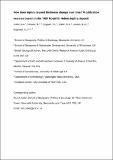Files in this item
How does tephra deposit thickness change over time? A calibration exercise based on the 1980 Mount St Helens tephra deposit
Item metadata
| dc.contributor.author | Cutler, N. A. | |
| dc.contributor.author | Streeter, R. T. | |
| dc.contributor.author | Engwell, S. L. | |
| dc.contributor.author | Bolton, M. S. | |
| dc.contributor.author | Jensen, B. J.L. | |
| dc.contributor.author | Dugmore, A. J. | |
| dc.date.accessioned | 2021-04-13T23:49:05Z | |
| dc.date.available | 2021-04-13T23:49:05Z | |
| dc.date.issued | 2020-07-01 | |
| dc.identifier | 268365386 | |
| dc.identifier | 2f5c3787-0bea-452b-93e3-f4695bc64893 | |
| dc.identifier | 85085499191 | |
| dc.identifier | 000539437500003 | |
| dc.identifier.citation | Cutler , N A , Streeter , R T , Engwell , S L , Bolton , M S , Jensen , B J L & Dugmore , A J 2020 , ' How does tephra deposit thickness change over time? A calibration exercise based on the 1980 Mount St Helens tephra deposit ' , Journal of Volcanology and Geothermal Research , vol. 399 , 106883 . https://doi.org/10.1016/j.jvolgeores.2020.106883 | en |
| dc.identifier.issn | 0377-0273 | |
| dc.identifier.other | ORCID: /0000-0003-2261-4540/work/75248653 | |
| dc.identifier.uri | https://hdl.handle.net/10023/23020 | |
| dc.description | This research was supported by grants from the Royal Geographical Society (ref: SRG 01/18) and Quaternary Research Association to NAC. | en |
| dc.description.abstract | Tephra layers are frequently used to reconstruct past volcanic activity. Inferences made from tephra layers rely on the assumption that the preserved tephra layer is representative of the initial deposit. However, a great deal can happen to tephra after it is deposited; thus, tephra layer taphonomy is a crucial but poorly understood process. The overall goal of this research was to gain greater insight into the taphonomy of terrestrial tephra layers, specifically the extent to which deposit thickness is altered over time, with implications for tephra volume estimation. We approached this by a)conducting a new survey of the tephra layer from the recent, well-studied eruption of Mount St Helens on May 18th, 1980 (MSH1980); b)modelling the tephra layer thickness using a mathematical technique and c)comparing our results with an equivalent model based on measurements taken immediately after the eruption. In this way, we aimed to quantify any losses and transformations that have occurred. During our study, we collected measurements of tephra layer thickness from 86 locations ranging from <20 to >600 km from the vent. Geochemical analysis was used to identify tephra of uncertain origin. Our results indicated that the extant tephra layer at undisturbed sites was representative of the original deposit: overall, preservation in these locations (in terms of thickness, stratigraphy and geochemistry) had been remarkably good. However, the isopach maps generated from our measurements diverged from isopachs produced in the same way, but derived from the original survey data. Furthermore, our estimates of the quantity of tephra produced during the eruption greatly exceeded previous estimates of the fallout volume. In our study, inaccuracies in the modelled fallout arose from issues of sampling strategy, rather than taphonomy. Our results demonstrate the sensitivity of volcanological reconstructions to measurement location, and the great importance of reliably measured low/zero values in reconstructing tephra deposits. | |
| dc.format.extent | 1831543 | |
| dc.language.iso | eng | |
| dc.relation.ispartof | Journal of Volcanology and Geothermal Research | en |
| dc.subject | Cubic B-spline | en |
| dc.subject | Electron microprobe | en |
| dc.subject | Isopach maps | en |
| dc.subject | Mount St Helens | en |
| dc.subject | Taphonomy | en |
| dc.subject | Volcanological reconstruction | en |
| dc.subject | G Geography (General) | en |
| dc.subject | Geophysics | en |
| dc.subject | Geochemistry and Petrology | en |
| dc.subject | DAS | en |
| dc.subject.lcc | G1 | en |
| dc.title | How does tephra deposit thickness change over time? A calibration exercise based on the 1980 Mount St Helens tephra deposit | en |
| dc.type | Journal article | en |
| dc.contributor.institution | University of St Andrews. School of Geography & Sustainable Development | en |
| dc.contributor.institution | University of St Andrews. Bell-Edwards Geographic Data Institute | en |
| dc.identifier.doi | https://doi.org/10.1016/j.jvolgeores.2020.106883 | |
| dc.description.status | Peer reviewed | en |
| dc.date.embargoedUntil | 2021-04-14 | |
| dc.identifier.url | https://eprints.ncl.ac.uk/266532 | en |
This item appears in the following Collection(s)
Items in the St Andrews Research Repository are protected by copyright, with all rights reserved, unless otherwise indicated.

